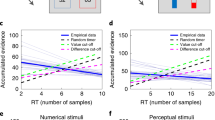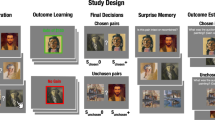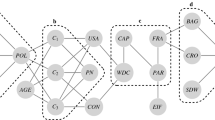Abstract
Standard models of decision-making assume each option is associated with subjective value, regardless of whether this value is inferred from experience (experiential) or explicitly instructed probabilistic outcomes (symbolic). In this study, we present results that challenge the assumption of unified representation of experiential and symbolic value. Across nine experiments, we presented participants with hybrid decisions between experiential and symbolic options. Participants’ choices exhibited a pattern consistent with a systematic neglect of the experiential values. This normatively irrational decision strategy held after accounting for alternative explanations, and persisted even when it bore an economic cost. Overall, our results demonstrate that experiential and symbolic values are not symmetrically considered in hybrid decisions, suggesting they recruit different representational systems that may be assigned different priority levels in the decision process. These findings challenge the dominant models commonly used in value-based decision-making research.
This is a preview of subscription content, access via your institution
Access options
Access Nature and 54 other Nature Portfolio journals
Get Nature+, our best-value online-access subscription
$29.99 / 30 days
cancel any time
Subscribe to this journal
Receive 12 digital issues and online access to articles
$119.00 per year
only $9.92 per issue
Buy this article
- Purchase on Springer Link
- Instant access to full article PDF
Prices may be subject to local taxes which are calculated during checkout







Similar content being viewed by others
Data availability
The data for the analysis are available in the following code repository: https://github.com/bsgarcia/RetrieveAndCompareAnalysis.
Code availability
The analysis was performed using Matlab R2021a. The code is available here: https://github.com/bsgarcia/RetrieveAndCompareAnalysis. The different experiments were conducted on a website programmed in Javascript ES6, HTML 5, CSS 3 (client-side) and PHP 8.1 (server-side). The code for the task is available here: https://github.com/bsgarcia/RetrieveAndCompare. A simple version of the task can be tested here: https://human-rl.scicog.fr/RandCTesting.
References
Von Neumann, J. & Morgenstern, O. Theory of Games and Economic Behavior (Princeton Univ. Press, 1944).
Rangel, A., Camerer, C. & Montague, P. R. A framework for studying the neurobiology of value-based decision making. Nat. Rev. Neurosci. 9, 545–556 (2008).
Herrnstein, R. J. Relative and absolute strength of response as a function of frequency of reinforcement. J. Exp. Anal. Behav. 4, 267 (1961).
Skinner, B. F. Science and Human Behavior (Simon and Schuster, 1965).
Bernoulli, D. Exposition of a new theory on the measurement of risk. Econometrica 22, 23–36 (1738).
Wakker, P. & Tversky, A. An axiomatization of cumulative prospect theory. J. Risk Uncertain. 7, 147–175 (1993).
Kahneman, D. & Tversky, A. Choices, values, and frames. American psychologist 39, 341 (1984).
De Martino, B., Kumaran, D., Seymour, B. & Dolan, R. J. Frames, biases, and rational decision-making in the human brain. Science 313, 684–687 (2006).
Glimcher, P. W. Foundations of Neuroeconomic Analysis (OUP USA, 2011).
Camerer, C. F. A review essay about foundations of neuroeconomic analysis by Paul Glimcher. J. Econ. Lit. 51, 1155–1182 (2013).
Vlaev, I., Chater, N., Stewart, N. & Brown, G. D. A. Does the brain calculate value? Trend. Cogn. Sci. 15, 546–554 (2011).
Stewart, N. EPS Prize Lecture: Decision by sampling: the role of the decision environment in risky choice. Q. J. Exp. Psychol. 62, 1041–1062 (2009).
Erev, I., Ert, E., Plonsky, O., Cohen, D. & Cohen, O. From anomalies to forecasts: toward a descriptive model of decisions under risk, under ambiguity, and from experience. Psychol. Rev. 124, 369 (2017).
Pessiglione, M. & Daunizeau, J. Bridging across functional models: the OFC as a value-making neural network. Behav. Neurosci. 135, 277 (2021).
Glimcher, P. W. Efficiently irrational: deciphering the riddle of human choice. Trend. Cogn. Sci. https://doi.org/10.1016/j.tics.2022.04.007 (2022).
Bartra, O., McGuire, J. T. & Kable, J. W. The valuation system: a coordinate-based meta-analysis of BOLD fMRI experiments examining neural correlates of subjective value. NeuroImage 76, 412–427 (2013).
Fouragnan, E., Retzler, C. & Philiastides, M. G. Separate neural representations of prediction error valence and surprise: evidence from an fMRI meta-analysis. Hum. Brain Mapp. 39, 2887–2906 (2018).
Hertwig, R. & Erev, I. The description–experience gap in risky choice. Trend. Cogn. Sci. 13, 517–523 (2009).
Madan, C. R., Ludvig, E. A. & Spetch, M. L. The role of memory in distinguishing risky decisions from experience and description. Q. J. Exp. Psychol. 70, 2048–2059 (2017).
Garcia, B., Cerrotti, F. & Palminteri, S. The description–experience gap: a challenge for the neuroeconomics of decision-making under uncertainty. Philos. Trans. R. Soc. B. 376, 20190665 (2021).
Kellen, D., Pachur, T. & Hertwig, R. How (in)variant are subjective representations of described and experienced risk and rewards? Cognition 157, 126–138 (2016).
Erev, I. et al. A choice prediction competition: choices from experience and from description. J. Behav. Decis. Mak. 23, 15–47 (2010).
FitzGerald, T. H. B., Seymour, B., Bach, D. R. & Dolan, R. J. Differentiable neural substrates for learned and described value and risk. Curr. Biol. 20, 1823–1829 (2010).
Heilbronner, S. R. & Hayden, B. Y. The description-experience gap in risky choice in nonhuman primates. Psychon. Bull. Rev. 23, 593–600 (2016).
Rescorla, R. A. & Wagner, A. R. (1972) A theory of Pavlovian conditioning: variations in the effectiveness of reinforcement and nonreinforcement. In A.H. Black & W.F. Prokasy (eds.), Classical conditioning II: current research and theory (pp. 64-99). New York: Appleton-Century-Crofts.
Behrens, T. E. J., Woolrich, M. W., Walton, M. E. & Rushworth, M. F. S. Learning the value of information in an uncertain world. Nat. Neurosci. 10, 1214–1221 (2007).
Sutton, R. S. & Barto, A. G. Reinforcement Learning: An Introduction (MIT Press, 2018).
Collins, A. G. E. The tortoise and the hare: interactions between reinforcement learning and working memory. J. Cogn. Neurosci. 30, 1422–1432 (2018).
Palminteri, S., Khamassi, M., Joffily, M. & Coricelli, G. Contextual modulation of value signals in reward and punishment learning. Nat. Commun. 6, 1–14 (2015).
Bavard, S., Rustichini, A. & Palminteri, S. Two sides of the same coin: beneficial and detrimental consequences of range adaptation in human reinforcement learning. Sci. Adv. 7, eabe0340 (2021).
Becker, G. M., DeGroot, M. H. & Marschak, J. Measuring utility by a single-response sequential method. Behav. Sci. 9, 226–232 (1964).
Rieskamp, J. & Otto, P. E. SSL: a theory of how people learn to select strategies. J. Exp. Psychol. Gen. 135, 207–236 (2006).
Savage, L. J. The Foundations of Statistics (Courier Corporation, 1972).
Lipman, B. L. Information processing and bounded rationality: a survey. Can. J. Econ. Rev. Can. Econ. 28, 42–67 (1995).
Chase, V. M., Hertwig, R. & Gigerenzer, G. Visions of rationality. Trends Cogn. Sci. 2, 206–214 (1998).
Gigerenzer, G. & Gaissmaier, W. Heuristic decision making. Annu. Rev. Psychol. 62, 451–482 (2011).
Maćkowiak, Bartosz and Matějka, Filip and Wiederholt, Mirko, Rational Inattention: A Review (June 1, 2021). ECB Working Paper No. 2021/2570. https://doi.org/10.2139/ssrn.3871534
Simon, H. A. Theories of bounded rationality. Decis. Organ. 1, 161–176 (1972).
Simon, H. A. & Newell, A. Human problem solving: the state of the theory in 1970. Am. Psychol. 26, 145 (1971).
Gigerenzer, G. E., Hertwig, R. E. & Pachur, T. E. Heuristics: The Foundations of Adaptive Behavior. (Oxford Univ. Press, 2011).
Simon, H. A. Administrative Behavior (Simon and Schuster, 2013).
R. Morgenstern, M. Heldmann and B. Vogt, "Portfolio Choice vs. Single Choice: Neural Differences in Cognitive Control," 2015 IEEE International Conference on Smart City/SocialCom/SustainCom (SmartCity), 2015, pp. 415-420, https://doi.org/10.1109/SmartCity.2015.106
Ellsberg, D. Risk, ambiguity, and the savage axioms. Q. J. Econ. 75, 643–669 (1961).
Frisch, D. & Baron, J. Ambiguity and rationality. J. Behav. Decis. Mak. 1, 149–157 (1988).
Camerer, C. & Weber, M. Recent developments in modeling preferences: uncertainty and ambiguity. J. Risk Uncertain. 5, 325–370 (1992).
Krajbich, I., Bartling, B., Hare, T. & Fehr, E. Rethinking fast and slow based on a critique of reaction-time reverse inference. Nat. Commun. 6, 7455 (2015).
Holt, C. A. & Laury, S. K. Risk aversion and incentive effects. Am. Econ. Rev. 92, 1644–1655 (2002).
Tversky, A. & Kahneman, D. Prospect theory: an analysis of decision under risk. Econometrica 47, 263–291 (1979).
Tversky, A. & Kahneman, D. Advances in prospect theory: cumulative representation of uncertainty. J. Risk Uncertain. 5, 297–323 (1992).
Prelec, D. The probability weighting function. Econometrica 66, 497 (1998).
Quiggin, J. Generalized Expected Utility Theory: The Rank-dependent Model (Springer Science & Business Media, 2012).
Soltani, A. & Koechlin, E. Computational models of adaptive behavior and prefrontal cortex. Neuropsychopharmacology 47, 1–14 (2021).
Rayner, K. Eye movements in reading and information processing: 20 years of research. Psychol. Bull. 124, 372 (1998).
Glöckner, A. & Herbold, A.-K. An eye-tracking study on information processing in risky decisions: evidence for compensatory strategies based on automatic processes. J. Behav. Decis. Mak. 24, 71–98 (2011).
Fiedler, S. & Glöckner, A. The dynamics of decision making in risky choice: an eye-tracking analysis. Front. Psychol. 3, 335 (2012).
Venkatraman, V., Payne, J. W. & Huettel, S. A. An overall probability of winning heuristic for complex risky decisions: choice and eye fixation evidence. Organ. Behav. Hum. Decis. Process. 125, 73–87 (2014).
Aimone, J. A., Ball, S. & King-Casas, B. It’s not what you see but how you see it: using eye-tracking to study the risky decision-making process. J. Neurosci. Psychol. Econ. 9, 137–144 (2016).
Dayan, P. & Abbott, L. F. Theoretical Neuroscience: Computational and Mathematical Modeling of Neural Systems (Computational Neuroscience Series, 2001).
Hayden, B. Y. & Niv, Y. The case against economic values in the orbitofrontal cortex (or anywhere else in the brain). Behav. Neurosci. 135, 192 (2021).
Bennett, D., Niv, Y. & Langdon, A. J. Value-free reinforcement learning: policy optimization as a minimal model of operant behavior. Curr. Opin. Behav. Sci. 41, 114–121 (2021).
Frank, M. J., D’Lauro, C. & Curran, T. Cross-task individual differences in error processing: neural, electrophysiological, and genetic components. Cogn. Affect. Behav. Neurosci. 7, 297–308 (2007).
Collins, A. G. & Frank, M. J. Opponent actor learning (OpAL): modeling interactive effects of striatal dopamine on reinforcement learning and choice incentive. Psychol. Rev. 121, 337 (2014).
Möller, M. & Bogacz, R. Learning the payoffs and costs of actions. PLoS Comput. Biol. 15, e1006285 (2019).
Redgrave, P., Prescott, T. J. & Gurney, K. The basal ganglia: a vertebrate solution to the selection problem? Neuroscience 89, 1009–1023 (1999).
Bar-Gad, I. & Bergman, H. Stepping out of the box: information processing in the neural networks of the basal ganglia. Curr. Opin. Neurobiol. 11, 689–695 (2001).
Rustichini, A. & Padoa-Schioppa, C. A neuro-computational model of economic decisions. J. Neurophysiol. 114, 1382–1398 (2015).
Padoa-Schioppa, C. & Conen, K. E. Orbitofrontal cortex: a neural circuit for economic decisions. Neuron. 96, 736–754 (2017).
Farashahi, S. et al. Metaplasticity as a neural substrate for adaptive learning and choice under uncertainty. Neuron. 94, 401–414.e6 (2017).
Zilker, V., Hertwig, R. & Pachur, T. Age differences in risk attitude are shaped by option complexity. J. Exp. Psychol. Gen. 149, 1644–1683 (2020).
Dukas, R. Costs of memory: ideas and predictions. J. Theor. Biol. 197, 41–50 (1999).
Afrouzi, H., Kwon, S. & Ma, Y. A model of costly recall (working paper, Columbia Univ., 2020).
Miller, K. J., Shenhav, A. & Ludvig, E. A. Habits without values. Psychol. Rev. 126, 292 (2019).
Krajbich, I., Armel, C. & Rangel, A. Visual fixations and the computation and comparison of value in simple choice. Nat. Neurosci. 13, 1292–1298 (2010).
Sepulveda, P. et al. Visual attention modulates the integration of goal-relevant evidence and not value. eLife 9, e60705 (2020).
Lichtenstein, S. & Slovic, P. The Construction of Preference (Cambridge Univ. Press, 2006).
Hayden BY, Niv Y. The case against economic values in the orbitofrontal cortex (or anywhere else in the brain). Behav. Neurosci. 135, 192–201 (2021).
Prissé‚ B. & Jorrat, D. Lab vs online experiments: no differences. J. Behav. Exp. Econ. 100, 101910 (2022).
Peer, E., Rothschild, D., Gordon A., Evernden, Z. & Damer, E. Data quality of platforms and panels for online behavioral research. Behav. Res. Methods. https://doi.org/10.3758/s13428-021-01694-3 (2021).
DuCharme, W. M. & Donnell, M. L. Intrasubject comparison of four response modes for “subjective probability” assessment. Organ. Behav. Hum. Perform. 10, 108–117 (1973).
Luce, R. D. The choice axiom after twenty years. J. Math. Psychol. 15, 215–233 (1977).
Acknowledgements
We thank A. Baillon, J. Daunizeau and S. Deneve for their helpful comments. S.P. is supported by the Agence National de la Recherche (CogFinAgent: ANR-21-CE23-0002-02; RELATIVE: ANR-21-CE37-0008-01; RANGE: ANR-21-CE28-0024-01). The article was prepared in the framework of a research grant of the Departement d’études cognitives (FrontCog ANR-17-EURE-0017). M.L. is supported by an SNSF Ambizione grant (PZ00P3_174127) and an ERC Starting Grant (948671). The funders had no role in study design, data collection and analysis, decision to publish or preparation of the manuscript.
Author information
Authors and Affiliations
Contributions
B.G. and S.P. designed the study. B.G. performed the experiments and curated the data. B.G. and S.P. defined the data analyses that were implemented by B.G. M.L. provided feedback on data analysis and the interpretation of the results. S.B.G. provided feedback on the interpretation of the results. B.G., S.P. and M.L. wrote the manuscript with input from S.B.G. All authors approved the final version of the manuscript for submission.
Corresponding authors
Ethics declarations
Competing interests
The authors declare no competing interests.
Peer review
Peer review information
Nature Human Behaviour thanks J. Traczyk, L. Polonio and the other, anonymous, reviewer(s) for their contribution to the peer review of this work. Peer reviewer reports are available.
Additional information
Publisher’s note Springer Nature remains neutral with regard to jurisdictional claims in published maps and institutional affiliations.
Supplementary information
Supplementary information
Supplementary Results, Figs. 1–12 and References.
Rights and permissions
Springer Nature or its licensor (e.g. a society or other partner) holds exclusive rights to this article under a publishing agreement with the author(s) or other rightsholder(s); author self-archiving of the accepted manuscript version of this article is solely governed by the terms of such publishing agreement and applicable law.
About this article
Cite this article
Garcia, B., Lebreton, M., Bourgeois-Gironde, S. et al. Experiential values are underweighted in decisions involving symbolic options. Nat Hum Behav 7, 611–626 (2023). https://doi.org/10.1038/s41562-022-01496-3
Received:
Accepted:
Published:
Issue Date:
DOI: https://doi.org/10.1038/s41562-022-01496-3
This article is cited by
-
Seeking Pleasure, Finding Trouble: Functions and Dysfunctions of Trait Sensation Seeking
Current Addiction Reports (2023)



